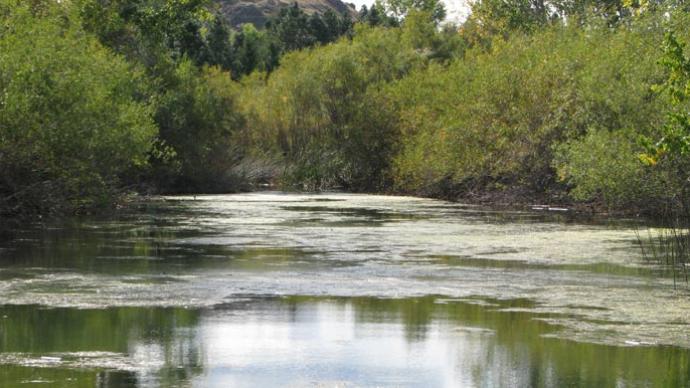
Pond management can be likened to a natural jigsaw puzzle. Take the pieces, put them together, and you have a picture perfect pristine pond, teeming with fish. Just the right amount of plant life coupled with perfectly healthy fish in water almost fit to drink.
Life is good. We are pleased.
Until one or two of those puzzle pieces no longer fit.
This time of year, biologists around the country receive too many phone calls about runaway vegetation. By July or August, it's tough to safely deal with obsessive greenery.
Plants need three things to grow. Temperature, food and sunlight. Take away any one of these factors, and plants don't exist. In summertime, native vegetation rings the periphery of plenty of ponds. At the inward edge of that ring, water is deeper than the sun's rays can penetrate. No sun, no grow. During winter, temperatures aren't conducive to excessive plant growth.
As pondmeisters, our job is to manage the "big three" best we can. EPA approved chemicals? Sure, they work. Most specifically target selected plants. Most are contact killers. None alter the "big three."
Understand the biological issues. Aeration? Great concept. An important piece of the pond management puzzle. Artificial aeration, properly conceived, creates vertical currents in water, bottom to top. This stirring action of millions of tiny air bubbles cascading their way to pond's surface, gently boiling the water, helps keep nutrients suspended in the water column. When nutrients are dissolved into water, plankton growth is enhanced. When plankton grows, underwater visibility changes, limiting the depth sunlight penetrates. Aeration can be good.
Springtime fertilization can also work for similar reasons. While aeration utilizes existing nutrients in water, fertilization adds new food to the system. Fertilization creates plankton in warm water, feeding the base of the food chain, then also acts as a sunlight filter.
Got deep pockets? Remove nutrient-rich shoreline soils with heavy equipment. That'll teach those pesky shallow water plants.
What about existing plants, and biological controls? The number one tool across the country is selected use of White Amur, or affectionately known as "grass carp." This cigar shaped, olive colored fish eats plants. Grass carp are grazers, and picky about what they eat. There are several issues about grass carp that must be weighed before you decide. Grass carp are regulated in most states. Learn your state's regulations. Grass carp won't eat all species of aquatic plants. Learn about the fish, and their menu. Know your pond, and it's plant life. If you don't know how big your pond is, the species of plants you have, and how much of the pond is covered by undesirable plants, you won't be able to determine the best stocking rate. Once you stock grass carp, they will be there more than 10 years. Don't overstock. Start with a low rate, maybe three or four per vegetated acre. Grass carp don't work fast. It may take two or three years to gain control. Don't rush them by stocking more. More grass carp are not necessarily better. Consider a combination of approved herbicides to gain control, and grass carp to maintain control. Grass carp like to move. They are notorious for moving downstream. Consider a barrier to keep them in. Some states require a barrier.
Other biological controls? Sure. Some organic gurus recommend using cornmeal on algae. It works, but then you have decaying cornmeal. If that's okay with you, it's okay with me. Barley straw, as it breaks down in water, releases a byproduct that kills algae. It's often a good choice. Beneficial microbes also target algae, but in a different way. Bacteria "consumes" decaying algae, interrupting its lifecycle enough to keep it from regenerating. But, bacteria must be added every week or two during algae season.
Researchers are looking at an underwater beetle which eats Eurasian water milfoil. Looks promising, but studies are underway to figure out the long lasting effects of the bug, compared to milfoil control.
Are there biological, natural controls for aquatic plants? Yes, there are. But, they are simply pieces of the puzzle, and should be viewed that way. As always, if you choose to use any of these tools, understand how they work, and when to use them. In order to do that, you need to understand the true nature of the problem.
Remember the problem? Sunlight, temperature and nutrients.
Learn how to manage one or two of the "big three."
Reprinted with permission from Pond Boss Magazine



